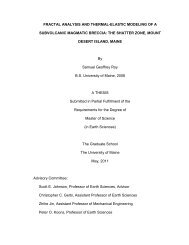design and characteristics of a split hopkinson pressure bar apparatus
design and characteristics of a split hopkinson pressure bar apparatus
design and characteristics of a split hopkinson pressure bar apparatus
You also want an ePaper? Increase the reach of your titles
YUMPU automatically turns print PDFs into web optimized ePapers that Google loves.
Results <strong>and</strong> Conclusion<br />
Overall the <strong>design</strong>ing <strong>and</strong> building <strong>of</strong> the<br />
Split Hopkinson Pressure Bar Apparatus<br />
was a success. We went from the thought<br />
<strong>of</strong> just <strong>design</strong>ing the gun at the beginning<br />
<strong>of</strong> the year to full building <strong>and</strong> testing at the<br />
end <strong>of</strong> last month. Although we were not<br />
able to obtain the predicted velocities we<br />
reached striker velocities in the range <strong>of</strong><br />
over 35 ft/sec while not even shooting at<br />
full potential. During the same velocity test<br />
we were able to gather several strain curves<br />
from an oscilloscope, which compared<br />
fairly well to those found in the military<br />
booklet <strong>and</strong> others online. Possible reasons<br />
for reduced velocities:<br />
1. Design calculations were based on the<br />
flow in a straight pipe - not through<br />
converging nozzle, but reduced throat<br />
area was necessary to keep the striker<br />
<strong>bar</strong> in the right position.<br />
2. Design calculations did not include air<br />
frictional factors-back <strong>pressure</strong>.<br />
3. Friction <strong>of</strong> the striker <strong>bar</strong> against the<br />
<strong>bar</strong>rel was not included in estimation.<br />
4. Experimental velocities were reduced<br />
by the uncertainty connected to<br />
computer hardware. Because a<br />
minimum time increment <strong>of</strong> the counter<br />
was 15 milliseconds at high <strong>pressure</strong>s<br />
did not give enough room to measure<br />
15<br />
elapsed time. Evidently, this <strong>design</strong><br />
class <strong>and</strong> project have given us the best<br />
learning experience. Undoubtedly we<br />
will encounter similarly challenging<br />
tasks in the real engineering world<br />
Recommendations<br />
1. To allow for the diversification <strong>of</strong><br />
testing out technical advisor Pr<strong>of</strong>essor<br />
Vince Caccese suggested putting a steel<br />
plate at the end <strong>of</strong> the <strong>bar</strong>rel. It will<br />
allow holding an object that would<br />
undergo destructive testing.<br />
2. More velocity calibration test<br />
performed at larger <strong>pressure</strong>s is<br />
required. At the same time find a way<br />
to get the time increments smaller in the<br />
computer program for better velocity<br />
accuracy.<br />
3. Search for better strain gages. Testing<br />
at high <strong>pressure</strong>s <strong>and</strong> velocities broke<br />
the gages located on the incident <strong>bar</strong>;<br />
therefore more durable ones should be<br />
used in the future.<br />
4. It will absolutely essential to resolve the<br />
counter problem, so the system can use<br />
smaller time increments to do the<br />
measurements.
















